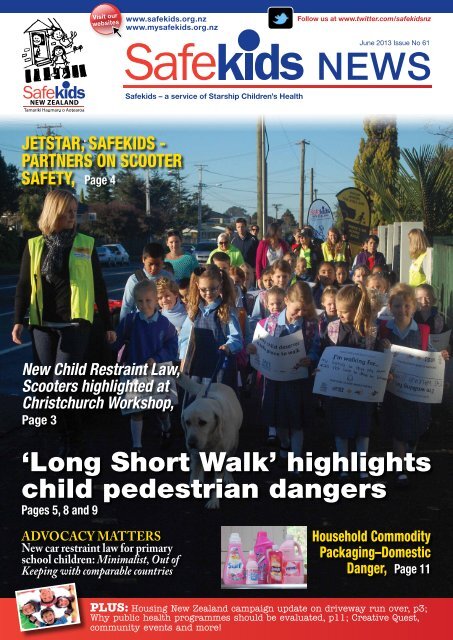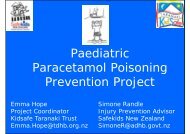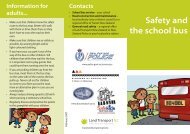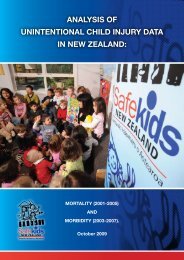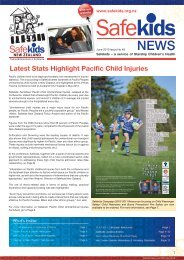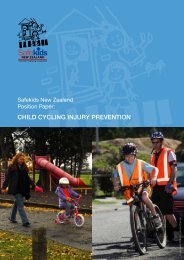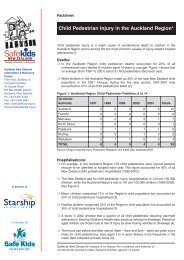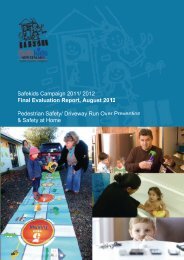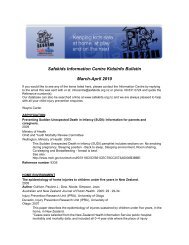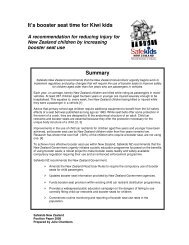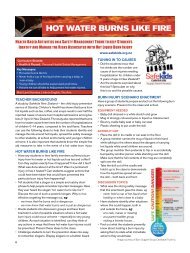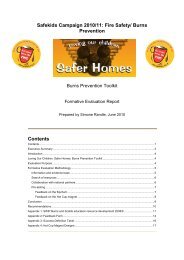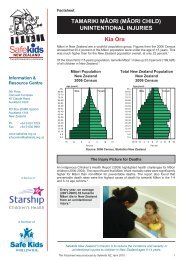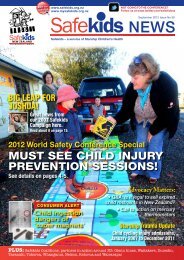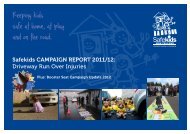Issue 61, June 2013 - Safekids
Issue 61, June 2013 - Safekids
Issue 61, June 2013 - Safekids
Create successful ePaper yourself
Turn your PDF publications into a flip-book with our unique Google optimized e-Paper software.
Visit our<br />
websites<br />
www.safekids.org.nz<br />
www.mysafekids.org.nz<br />
Follow us at www.twitter.com/safekidsnz<br />
<strong>June</strong> <strong>2013</strong> <strong>Issue</strong> No <strong>61</strong><br />
NEWS<br />
<strong>Safekids</strong> – a service of Starship Children’s Health<br />
JETSTAR, SAFEKIDS -<br />
PARTNERS ON SCOOTER<br />
SAFETY, Page 4<br />
New Child Restraint Law,<br />
Scooters highlighted at<br />
Christchurch Workshop,<br />
Page 3<br />
‘Long Short Walk’ highlights<br />
child pedestrian dangers<br />
Pages 5, 8 and 9<br />
ADVOCACY MATTERS<br />
New car restraint law for primary<br />
school children: Minimalist, Out of<br />
Keeping with comparable countries<br />
Household Commodity<br />
Packaging–Domestic<br />
Danger, Page 11<br />
PLUS: Housing New Zealand campaign update on driveway run over, p3;<br />
Why public health programmes should be evaluated, p11; Creative Quest,<br />
community events and more!
MESSAGE FROM THE DIRECTOR<br />
Building bridges for children<br />
Building bridges—or creating and nurturing partnerships is an<br />
essential part of <strong>Safekids</strong> New Zealand’s child injury prevention<br />
work. In this edition of <strong>Safekids</strong> News, we would like to welcome<br />
our new child safety allies.<br />
Jetstar announced last month that <strong>Safekids</strong> is the fifth recipient<br />
of it Flying Start Programme grant (page 4). Safety is a focus we<br />
share with Jetstar, and together we hope to deliver a scooter<br />
programme that will help reduce high scooter injury rates.<br />
FedEx and communities across the country also joined us as<br />
we celebrate the United Nations Global Road Safety Week, with<br />
Long Short Walks for pedestrian safety held across the country<br />
in May (pages 5, 8-9).<br />
We are also pleased with Housing New Zealand’s progress on its<br />
driveway run over-focused landscaping project. 12,759 homes<br />
are expected to benefit from this, and we are thrilled to be part<br />
of their campaign.<br />
And finally at the <strong>Safekids</strong> Campaign Workshop for <strong>2013</strong> in<br />
Christchurch (page 3), it was great to see a lot of new faces and<br />
our loyal community partners. The level of commitment to injury<br />
prevention as the city and the region rebuilds is wonderful.<br />
There are five more community workshops in <strong>2013</strong> (page3).<br />
The <strong>Safekids</strong> New Zealand team with children and staff from the Aro<br />
Arataki Children’s Centre in Greenlane doing a Long Short Walk for<br />
pedestrian safety.<br />
I hope you will join us as we continue our work to promote child<br />
injury prevention.<br />
Ann Weaver<br />
Director, <strong>Safekids</strong> New Zealand<br />
Congratulations Dr Coggan!<br />
<strong>Safekids</strong> congratulates Dr Carolyn Coggan<br />
who has been made a Member of the New<br />
Zealand Order of Merit for services to health.<br />
Dr Coggan is the Director of Safe Communities<br />
Foundation NZ, and has been involved in<br />
the establishment of the inaugural Injury<br />
Prevention Network in 1999. She has also<br />
been a key member of numerous health and safety initiatives. Dr<br />
Coggan was awarded Sweden's Karolinski Institute International<br />
Career Development Award in 2008 as well as the Te Manaia<br />
Leadership Award for Community Safety in 2008.<br />
<strong>Safekids</strong> News is <strong>Safekids</strong> NZ’s quarterly publication.<br />
For enquiries, contact the editor at anthony.rola@adhb.govt.nz.<br />
<strong>Safekids</strong> News encourages discussion within the injury prevention<br />
community. Opinion articles or articles with bylines reflect the<br />
views of the author, and do not necessarily reflect the views of<br />
<strong>Safekids</strong> New Zealand<br />
About <strong>Safekids</strong> New Zealand<br />
<strong>Safekids</strong> New Zealand is the injury prevention service of Starship<br />
Children’s Health and a member of Safe Kids Worldwide. Our<br />
mission is to reduce the incidence and severity of unintentional<br />
injuries to children in New Zealand aged 0 - 14 years.<br />
KidSafe twins!<br />
These super-cute twins are Milan Sharat and Anjali Anita.<br />
Congratulations to mum Eloise Pollard (Kidsafe Taranaki)<br />
and dad Murali, and thanks for sending us the photo.<br />
<strong>Safekids</strong> NZ Team<br />
Ann Weaver, Director<br />
Anthony Rola, Marketing and Communications<br />
Chantal Woodfine, Partnerships Manager<br />
Gervaise Ledger, Team Support<br />
Joanna Milne, PA to the Director<br />
Moses 'Alatini, Policy Analyst<br />
Patricia Bolton, Policy Analyst<br />
Simone Randle, Injury Prevention Advisor<br />
Victoria Jarvis, Coalition Coordinator<br />
Wayne Carter, Information Specialist<br />
A Service Of<br />
Make a difference<br />
<strong>Safekids</strong> New Zealand encourages the involvement of government,<br />
community, industry, decision makers and families in child safety. If<br />
you would like to know more about us, wish to advocate on behalf<br />
of children in your community, or partner in a programme with us,<br />
contact us at:<br />
COVER: The St. Mary’s School (Ellerslie)<br />
Long Short Walk with the <strong>Safekids</strong> New<br />
Zealand team and TVNZ’ Breakfast crew.<br />
See page 5 for story<br />
<strong>Safekids</strong> New Zealand<br />
PO Box 26488, Epsom, Auckland 1344, New Zealand.<br />
Telephone: +64-9 630 9955<br />
Fax: +64-9-630 99<strong>61</strong><br />
www.safekids.org.nz<br />
2<br />
<strong>Safekids</strong> News: <strong>June</strong> <strong>2013</strong> <strong>Issue</strong> No <strong>61</strong>
INJURY PREVENTION NEWS<br />
NEW CHILD RESTRAINT LAW, SCOOTERS HIGHLIGHTED<br />
AT SAFEKIDS CHRISTCHURCH WORKSHOP<br />
The new child restraint law and rise in scooter-related injuries were the hot<br />
topics during the opening leg of the <strong>2013</strong> <strong>Safekids</strong> Information & Planning<br />
Day workshop series held recently in Christchurch.<br />
51 attendees from the council, Police,<br />
early childhood education, schools, out of<br />
school programmes, parent education, Age<br />
Concern, Plunket, health, ACC, community<br />
and family services packed Fendalton<br />
Service Centre.<br />
Booster seats dominated the discussions.<br />
“Many raised issues about challenges<br />
parents and caregivers will face once the<br />
new child restraint law is in place, how<br />
these can be overcome, and what <strong>Safekids</strong><br />
resources are available to them,” said<br />
<strong>Safekids</strong> Injury Prevention Advisor and<br />
workshop facilitator Simone Randle.<br />
The sharp rise in scooter-related injuries<br />
was also a revelation to attendees.<br />
‘Hopefully this will lead to more scooter<br />
safety-related initiatives.” Simone said.<br />
The <strong>Safekids</strong> Driveway Run Over<br />
Awareness Kit was also a hit. “Attendees<br />
meet with kit coordinators and shared<br />
information on how they can access it,”<br />
she added.<br />
Overall the workshop was a success.<br />
“Aside from the great discussions, we were<br />
really impressed with the diversity of skills<br />
and a willingness to share expertise among<br />
attendees.”<br />
“Special thanks to Christchurch City<br />
Council, specifically to Community Safety,<br />
Injury and Harm Advisor Allison Houston for<br />
helping us plan the day,” Simone added.<br />
<strong>2013</strong> <strong>Safekids</strong> Workshop<br />
Schedule<br />
Four more child injury prevention<br />
workshops are scheduled this year:<br />
• Porirua, 11 <strong>June</strong>: Focus on<br />
skateboards and scooters, passenger<br />
safety, driveway safety and falls.<br />
• Hamilton, 5 July: Focus on<br />
skateboards and scooters, passenger<br />
safety, burns prevention and falls.<br />
• Auckland, 9 July: Focus on<br />
skateboards and scooters, passenger<br />
safety, road traffic injuries in the<br />
Auckland Region, standards and<br />
product safety, Swimming Pool<br />
Fencing Act<br />
• Northland, 24 July: driveway safety,<br />
passenger safety, falls and helmets<br />
A certificate of attendance will be<br />
given to workshop attendees. For more<br />
information or to book a seat, visit/<br />
email:<br />
www.safekids.org.nz/index.php/page/<br />
Workshops<br />
VictoriaJ@adhb.govt.nz<br />
First batch of driveway safety inspections<br />
at state houses nearly complete<br />
At this Hamilton<br />
property speed<br />
humps and a row of<br />
rubber wheelstops<br />
were installed to<br />
improve pedestrian<br />
and driveway safety.<br />
At Papakura a fence<br />
is installed in this<br />
home to separate the<br />
play area from the<br />
driveway.<br />
Housing New Zealand Corporation (HNZC)<br />
is on track to have inspected the driveway<br />
safety of all of its state houses where there<br />
are children below five years old by the end<br />
of <strong>June</strong>.<br />
There are less than 1,000 houses<br />
left to inspect out of the 12,594<br />
houses identified. Of this total,<br />
7,000 are in Auckland and<br />
approximately 300 community<br />
group houses with children<br />
in residence have also been<br />
inspected.<br />
HNZC has committed ongoing<br />
funding to the driveway safety<br />
programme to support work being<br />
done by <strong>Safekids</strong>. Depending<br />
on the type of property, they are<br />
delivering a range of interventions<br />
to make driveways safer for children. These<br />
include installing fencing, gates, speed<br />
restriction signs, speed humps and convex<br />
mirrors on blind corners.<br />
“Our first priority is to make improvements<br />
to those properties with children aged 18<br />
months to two years, as these ages have<br />
been identified as most at risk from being<br />
run over,” says HNZC Project Manager<br />
Owen Blackburn.<br />
HNZ has been working with <strong>Safekids</strong> New<br />
Zealand to address the key risk factors<br />
associated with driveway runover injuries<br />
as described in the <strong>Safekids</strong> position<br />
paper Child Driveway Run Over Injuries.<br />
Downloaded this paper at:<br />
www.safekids.org.nz/index.php/page/<br />
Position_Papers<br />
3<br />
<strong>Safekids</strong> News: <strong>June</strong> <strong>2013</strong> <strong>Issue</strong> No <strong>61</strong>
INJURY PREVENTION NEWS<br />
JETSTAR, SAFEKIDS – PARTNERS ON SCOOTER SAFETY<br />
Jetstar in May announced that <strong>Safekids</strong> New Zealand is the recipient of the airline’s fifth<br />
Flying Start Programme grant. <strong>Safekids</strong> is using the grant (made up of $15,000 cash and<br />
$15,000 worth of flights) to promote scooter safety at schools.<br />
Ann Weaver, Director of <strong>Safekids</strong>, said it’s<br />
wonderful to see kids getting active with<br />
their scooters.<br />
“It is also important for children, parents<br />
and schools to take simple but important<br />
steps to help avoid serious injuries,<br />
including requiring safety helmets when<br />
scootering to and from school,” she said.<br />
David Hall, Jetstar Australia & New<br />
Zealand CEO, said the airline appreciated<br />
the holistic approach <strong>Safekids</strong> is taking to<br />
help raise safety awareness.<br />
“The Flying Start judging panel was really<br />
impressed with all the great initiatives<br />
<strong>Safekids</strong> undertakes and we’re thrilled<br />
to be supporting such a worthy cause.<br />
Safety is always the<br />
number one priority at<br />
Jetstar and <strong>Safekids</strong><br />
does a wonderful<br />
job promoting child safety every day,<br />
everywhere for everyone in New Zealand.”<br />
Mr Hall said.<br />
Jetstar Captain Richard Falkner and rugby league legend Steve Price joined Jetstar<br />
and <strong>Safekids</strong> at the Flying Start grant announcement at Vauxhall Primary School in<br />
Devonport. Thank you Principal Gary Lawrence for helping us organise the day.<br />
BRENT BRADLEY: Scooter Safety and Helmet Champion<br />
Brent Bradley is a very lucky boy to escape permanent brain injury.<br />
The 9-year-old fell off his scooter and<br />
landed on his head. Parents Conan and<br />
Leisje rushed him to Starship Hospital<br />
where a 10cm round piece of Brent’s skull<br />
was removed.<br />
Brent has done well to recover from his<br />
injuries, but has ongoing visits with brain<br />
injury specialists to make sure he gets<br />
better.<br />
It’s been a hard journey for the whole<br />
family, and has turned them into ‘no<br />
helmet, no scooter’ champions.<br />
And Brent is the number 1 advocate for<br />
safety helmets. “I still see a lot of kids<br />
going to school without helmets and I<br />
have shown them the [scar] picture on my<br />
iPod so they can see what can happen.”<br />
Unfortunately Brent’s story is becoming<br />
increasingly common. According to<br />
<strong>Safekids</strong> New Zealand’s Position Paper<br />
Child Skateboard and Scooter Injury<br />
Prevention, the rise in popularity of<br />
scootering has been coupled with a<br />
marked increase in scooter-related injury.<br />
This position paper presents New Zealand<br />
data and international research on<br />
skateboard and scooterrelated<br />
injury, and<br />
relevant NZ legislation,<br />
safety standards and<br />
effective interventions to<br />
reduce injury.<br />
To download the<br />
Child Skateboard<br />
and Scooter Injury<br />
Prevention position<br />
paper, visit:<br />
www.safekids.org.nz/<br />
index.php/page/Position_<br />
Papers<br />
4<br />
<strong>Safekids</strong> News: December <strong>June</strong> <strong>2013</strong> 2012 <strong>Issue</strong> <strong>Issue</strong> No <strong>61</strong>No 59
UN GLOBAL ROAD SAFETY WEEK<br />
Walk highlights<br />
child pedestrian dangers<br />
<strong>Safekids</strong> New Zealand, together with communities and partners around<br />
the country, took to the streets to advocate for child pedestrian safety by<br />
doing ‘Long Short Walks’ during Road Safety Week (6-12 May).<br />
The Long Short Walk is a UN and WHO<br />
supported initiative that called for<br />
communities around the world to organise<br />
the walks. <strong>Safekids</strong> Long Short Walks were<br />
held in Whangarei, Auckland, Tokoroa,<br />
Hamilton, Rotorua, Taupo, Whanganui,<br />
Wairoa, Christchurch and Invercargill.<br />
In Auckland, <strong>Safekids</strong> and St. Mary’s<br />
Catholic School in Ellerslie staged what<br />
could be Auckland’s largest walking school<br />
bus event this year—over 40 children and<br />
parents walking together to school.<br />
Breakfast TV, the country’s top morning TV<br />
show was on hand to cover the event.<br />
“The short term goal of the Long Short<br />
Walk was to prevent even a single<br />
pedestrian fatality during the week” said<br />
Ann Weaver, director of <strong>Safekids</strong> New<br />
Zealand.<br />
According to the UN and the World Health<br />
Organisation (WHO), more than 5,000<br />
pedestrians are killed on the world’s<br />
roads each week. Many of those killed are<br />
children walking to and from schools. In<br />
New Zealand, an average of eight child<br />
pedestrians die every year, and a further<br />
107 children are injured severely enough to<br />
be hospitalised.<br />
“The long term goal is to advocate<br />
for the right of all children to be safe<br />
pedestrians. Hopefully our actions will urge<br />
governments around the world to make<br />
greater investment in safe footpaths, cycleways<br />
and crossing points, and on streets<br />
with lower speed limits, especially around<br />
schools,” Ann added.<br />
Thank you for supporting the Long Short Walk!<br />
Thanks to FedEx and Safe Kids Worldwide for sponsoring the<br />
<strong>Safekids</strong> New Zealand Long Short Walks.<br />
Thanks also to SOAR Print for the signboards.<br />
Read about other Long Short Walk events held across the country on<br />
pages 8 and 9. View photos of walks in NZ and around the world here:<br />
www.flickr.com/groups/longshortwalk<br />
TOKOROA: Keeping rural kids safe<br />
A Long Short Walk led by Tokoroa<br />
Police Constable Louise Samuel with<br />
30 students and staff from David Henry<br />
Primary School highlighted the dangers<br />
children experience every time they<br />
walk to school.<br />
Maraetai Road is a busy road, and it's<br />
common to see logging trucks, tankers<br />
and heavy traffic especially around the<br />
school drop off and pickup times.<br />
Tokoroa Council of Social Services’<br />
Megan Atkins said the community<br />
is aware of this issue, and is coming<br />
together to discuss possible<br />
solutions.<br />
“We’d love to see better visibility<br />
at crossings, lower speeds where<br />
necessary, traffic calming measures,<br />
and more road and pedestrian safety<br />
education for children and adults,”<br />
Megan said.<br />
5<br />
<strong>Safekids</strong> News: <strong>June</strong> <strong>2013</strong> <strong>Issue</strong> No <strong>61</strong>
ADVOCACY MATTERS<br />
New car restraint law for primary school children:<br />
'MINIMALIST, OUT OF KEEPING WITH LEGISLATION IN<br />
COMPARABLE COUNTRIES'<br />
By Dr. Elizabeth Segedin<br />
Best practice. Primary school aged<br />
children should travel in the rear seat<br />
in a booster until they are 148cm tall.<br />
The New Zealand Government has recently<br />
announced an improvement in the law covering the<br />
restraint of children when they travel as passengers<br />
in cars, requiring restraint in a size appropriate<br />
device until the 7th birthday.<br />
While this is a welcome change from the 5th birthday, it is still<br />
minimalist and out of keeping with legislation in comparable<br />
countries. Most importantly this legislation is still not giving<br />
Kiwi parents the full facts about keeping their children safe as a<br />
passenger.<br />
There are 2 key components of height. Firstly, the sitting height,<br />
which is the height from the seat base to the shoulder anchor<br />
point. Can the child sit up high enough so that the shoulder<br />
portion of the belt passes over the mid point of the bony shoulder<br />
and sternum (breast bone) and not over the neck?<br />
The science behind<br />
the way children need<br />
to be restrained in cars<br />
is actually pretty simple,<br />
logical and not based on<br />
age or weight.<br />
The determinant of<br />
restraint mechanism is<br />
HEIGHT.<br />
Secondly, the length of<br />
the thighs from the back<br />
of the knee to the seat<br />
back in relation to the<br />
depth of the seat in the<br />
car. Can the child sit up<br />
straight with the knees<br />
bent comfortably over the<br />
seat edge and have the lap<br />
portion of the belt lie low<br />
over the hips and anchor<br />
over the strong bony pelvic<br />
and hip bones?<br />
In order to sit up straight<br />
for the first requirement, the child needs to be able to have their<br />
backside right against the seat back and still have their knees bent<br />
over the seat edge.<br />
If these dimensions are not sufficient, the child slouches back –<br />
the lap portion of the belt rides up over the abdomen exposing<br />
the underlying organs to injury and the sash part of the belt rides<br />
up over the neck risking injury to both the neck and head and<br />
exposing the child to a 2 to 4 fold risk of serious injury.<br />
A Booster seat corrects this mismatch. It lifts the child up so that<br />
both portions of the seat belt are routed over the appropriate bony<br />
body part which can better sustain the force of deceleration in a<br />
crash.<br />
There is good evidence to support the use of a booster seat once<br />
a child has transitioned out of their child car seat and in continuing<br />
to do so until the child achieves the above dimensions and is able<br />
to fit the adult sized seat and seat belt arrangement.<br />
Studies confirm that this “safe” height is between 145 and 150 cm<br />
and usually achieved somewhere between 9 and 12 years of age.<br />
Around the globe booster seat legislation is increasingly<br />
recognising height as the determinant with States in Canada, the<br />
UK and Europe legislating from 135 to 150 cm in height. Police<br />
vehicles in New Zealand are serendipitously 148cm in height<br />
which matches the science and is therefore a practical and easy<br />
method of enforcement.<br />
As well as being significantly safer in a booster seat, primary<br />
school aged children up until the age of 12 are also less at risk<br />
of injury in the rear seat and many countries including Australia<br />
have recommendations against children travelling in the front<br />
passenger seat.<br />
This is particularly so if there is a frontal airbag in this seating<br />
position which is designed to deploy at chest height for an adult<br />
and which of course is at head height for a child.<br />
The upcoming New Zealand law sets only a minimal<br />
recommendation. Best practice continues to be that primary<br />
school aged children should travel in the rear seat in a booster<br />
until they are 148cm in height regardless of age.<br />
Dr Elizabeth Segedin is an intensivist at the Starship Paediatric<br />
Intensive Care Unit (PICU). You can email her at:<br />
Liz.Segedin@adhb.govt.nz<br />
Countries that have a booster seat law<br />
Below is a list of countries that have booster seat laws with<br />
height and age requirements. In comparison, the proposed<br />
New Zealand law change taking effect in November will<br />
extend the mandatory use of child restraints to children<br />
aged 0 to 6 years, with children aged 7 years having to use<br />
a child restraint if one is available.<br />
Country Height requirement Age requirement<br />
United Kingdom 135 centimetres 0-12 years<br />
Canada<br />
(British Columbia)<br />
145 centimetres 0-10 years<br />
Germany 150 centimetres 0-12 years<br />
Hungary 150 centimetres 0-12 years<br />
Spain 150 centimetres 0-12 years<br />
Switzerland 150 centimetres 0-12 years<br />
Canada (Quebec)<br />
United States<br />
63 centimetres seated<br />
height<br />
Varies by state.<br />
No age requirement<br />
Varies by state,<br />
generally 0-9 years<br />
Belgium No height requirement 0-12 years<br />
Australia No height requirement 0-7 years<br />
Canada (Alberta) No height requirement 0-7 years<br />
Japan No height requirement 0-7 years<br />
6<br />
<strong>Safekids</strong> News: <strong>June</strong> <strong>2013</strong> <strong>Issue</strong> No <strong>61</strong>
PRODUCT SAFETY/ TRAUMA UPDATE<br />
Where is the milk? Lined up together milk and<br />
chemical packaging are indistinguishable.<br />
Household Commodity Packaging –<br />
Domestic Danger<br />
By Tulia Moss<br />
As we snake our trolleys through<br />
the supermarket, zigzagging<br />
down the aisles, we find products<br />
sorted by type.<br />
Generally, fresh and fruits greet us at entry.<br />
In the centre of the store, we generally<br />
encounter walls of boxed and packaged<br />
goods, which are stacked with the<br />
premium products at eye level, and the<br />
cheaper, every day items, on harder-toread<br />
shelves.<br />
Domestic commodity products like bread<br />
and milk are usually at the end, just before<br />
the checkout. Milk varieties stretch from<br />
ultra-trim to full fat in many shapes and<br />
sizes.<br />
Grouped together on the refrigerator<br />
shelves, it’s clear that all those packs<br />
contain milk.<br />
However away from the consumer context<br />
of the stores, the signs for milk become<br />
incoherent.<br />
Milk packaging graphics have become<br />
indecipherable when placed in a nonretail<br />
environment and as a result, do not<br />
provide for the health and safety needs<br />
of children. Alarmingly, milk packaging<br />
shares similar signs in its materiality,<br />
size, shape, colour, typography, imagery<br />
and construction to many other massproduced<br />
commodity products, both<br />
edible and toxic.<br />
In the most recent milk packaging<br />
innovation, the three-skinned ultra-white<br />
pigment bottle is texturally similar to<br />
many toxic household products, and just<br />
like some detergents, the contents are<br />
invisible.<br />
This poses a serious risk for young<br />
children who may mistake the plastic jugs<br />
of cleaning products for milk. Just as we<br />
consumers in the supermarket reach for<br />
the content shelved, the hungry child will<br />
reach for the kitchen bench.<br />
Children are being poisoned from<br />
consuming detergents (NZNPC, 2004).<br />
Between <strong>June</strong> 2002 and March 2005, <strong>61</strong>5<br />
New Zealand children read packaging of<br />
toxic product as food or drink. To decipher<br />
packaging for a detergent or milk, a child<br />
would have to be able to read, and this<br />
is a skill most cannot do until they are at<br />
least five years old.<br />
Alarmingly, milk packaging<br />
shares similar signs in its<br />
materiality, size, shape,<br />
colour, typography, imagery<br />
and construction to many<br />
other mass-produced<br />
commodity products, both<br />
edible and toxic.<br />
Milk packaging needs careful researchdriven<br />
design to ensure it is distinctive<br />
from poisons, and is user-friendly for<br />
readers and non-readers at home as well<br />
as on the supermarket shelf.<br />
Tulia Moss is a lecturer and packaging<br />
designer at the Massey University School<br />
of Design in Wellington. Tulia is also the<br />
author of ‘Goodness: De-signing the<br />
Nature and Culture of New Zealand<br />
Packaging Signs’ a thesis available online<br />
at www.massey.ac.nz). To contact Tulia,<br />
email:<br />
T.J.Moss@massey.ac.nz<br />
Starship Trauma Update:<br />
Vehicle occupant injury admissions, 2007 to 2012<br />
Ethnicity 0 - 4 yrs 5 - 9 yrs 10 - 14 yrs Total<br />
Maori 26 20 35 81<br />
Pacific Peoples 12 16 17 45<br />
European 26 39 69 134<br />
Other 8 11 9 28<br />
Total 72 86 130 288<br />
Vehicle occupant injury admissions to Starship Children's Hospital,<br />
2007 to 2012<br />
In the six year period 2007 to 2012, a total of 288 children<br />
aged fourteen years or less were admitted to Starship<br />
Children's Hospital as the result of injuries sustained as<br />
occupants in a motor vehicle involved in a traffic crash.<br />
This equates to 48 admissions per year.<br />
Children aged 10 to 14 years were most frequently injured<br />
accounting for nearly half (45%, 130) of all occupant<br />
injuries.<br />
Children of European and Maori decent accounted for 47%<br />
(134) and 28% (81) of occupant injuries respectively.<br />
7<br />
<strong>Safekids</strong> News: <strong>June</strong> <strong>2013</strong> <strong>Issue</strong> No <strong>61</strong>
THE CAMPAIGN TRAIL: The Long Short Walk<br />
WHANGAREI: ‘Green Man’ comes to life at safety walk<br />
Walk safe with the “Traffic<br />
Light Green Man”—what<br />
an excellent idea to<br />
promote pedestrian safety<br />
and sustainable transport<br />
by the Whangarei team!<br />
The Green Man Long Short Walk in Whangarei<br />
was organized by RoadSafe Northland, Whangarei<br />
District Council, Police, Northland Regional<br />
Council, Northland District Health Board, Manaia<br />
PHO and members of the public.<br />
Road Safety Projects Facilitator Morag van der<br />
Veer said the green man support was a hit feature<br />
during the weekend’s rugby, football and netball<br />
games at Kensington Park.<br />
“We had about 22-30 walkers and an audience<br />
of hundreds. At times spectators joined in and<br />
walked with us,” Morag said.<br />
If you would like to know more about the<br />
Whangarei coalition’s awesome Green Man idea,<br />
email Morag at:<br />
safeacts@xtra.co.nz<br />
The Whangarei Long Short Walk team would like to thank Outdoor Connection, Opus,<br />
Mokaba, Clapham’s Clock Museum, KiwiNorth, Rebel Sport and local Councillor<br />
John Williamson for supporting the event.<br />
Christchurch City Council Injury<br />
Prevention Advisor Allison Houston<br />
went on a Long Short Walk with the<br />
region’s road safety coordinators<br />
and community safety and crime<br />
prevention team at Christchurch’s<br />
central city streets.<br />
Photo shows the team at the newly<br />
marked pedestrian and cycle space<br />
along Colombo Street (left), and with<br />
a Stronger Christchurch Infrastructure<br />
Rebuild Team (SCIRT) member (right).<br />
8<br />
<strong>Safekids</strong> News: <strong>June</strong> <strong>2013</strong> <strong>Issue</strong> No <strong>61</strong><br />
TAUPO: Walking bus<br />
promotes safety<br />
The <strong>Safekids</strong> Taupo Coalition and Hilltop Primary School<br />
celebrated Road Safety Week by taking a Long Short Walk<br />
to school. The walk was supported by the Police, Sport<br />
Waikato, Taupo Violence Intervention Network (TVIN),<br />
Taupo District Council and the Rural Education Activities<br />
Programme (REAP) Central Plateau.<br />
The walking school bus also took the opportunity to learn<br />
about pedestrian safety, such as watching out for sneaky<br />
driveways, how to cross roads safely, being safe when<br />
walking to and from school.<br />
The <strong>Safekids</strong> Taupo Coalition also promoted driveway safety<br />
at the Community Fun Day held the next day.<br />
CHRISTCHURCH: Walking to rebuild safer streets
THE CAMPAIGN TRAIL: Community events<br />
TE WAIROA: Long Short Walk for our Tamariki<br />
Kahungunu Executive Injury Prevention Coordinator Cheryl Te Amo and<br />
Health Promoter Anton Fasso led a Long Short Walk in Wairoa together with<br />
students from Frasertown School.<br />
This Long Short Walk was just one of many held in New Zealand and around<br />
the world to promote pedestrian safety. Read about Long Short Walks held<br />
around the world during the <strong>2013</strong> UN Global Road Safety Week at:<br />
www.thelongshortwalk.org<br />
SOUTHLAND: Bright Sparks walk for safety<br />
Road Safety Southland, NZ Police, Kindergartens South and Plunket<br />
organised a Long Short Walk during the Bright Sparks Road Show in May.<br />
The walk was one of many activities<br />
during the Bright Sparks roadshow that<br />
toured 15 kindergartens with the theme<br />
Bright Pedestrian, Bright Rider, Bright<br />
Passenger and Bright Play.<br />
“Some kindys prepared road safety<br />
themed songs during our visit, and many<br />
had a bright-themed day, such as bright<br />
dress day and bright hat day. Some<br />
had a feet day, zebra day and even a<br />
themed shared lunch with traffic light<br />
sandwiches,” Kathryn said.<br />
More importantly, 646 children learned<br />
about important road safety information<br />
by attending the sessions or taking home<br />
information packs. 238 Child restraint<br />
checks were also completed over the 5<br />
days.<br />
For more information about Plunket<br />
Southland’s Bright Sparks programme,<br />
email:<br />
Kathryn.Impelmans@plunket.org.nz<br />
HAMILTON: Playgroup<br />
walks for safety<br />
Threatening rain clouds couldn’t stop the<br />
Hamilton Plunket Car Seat Service team and<br />
Little Connections Play Group from showing their<br />
support for pedestrian safety.<br />
The 1.2 km Long Short Walk started at the main<br />
Hamilton Plunket building and went past busy streets,<br />
main intersections, a kindy and a school.<br />
“The kids were fantastic. They were so enthused during the walk<br />
and loved that we went past a digger on a construction site. They<br />
were very good at looking for cars before crossing and holding<br />
hands when needed,” said walk organiser and Hamilton Plunket<br />
Child Restraint Technician Wendy Woods said.<br />
Thanks to the parents, children and Emma Gilmore of Little<br />
Connections and Plunket Hamilton Branch Co-ordinator Shari<br />
Rutene for helping organise the event.<br />
9<br />
<strong>Safekids</strong> News: <strong>June</strong> <strong>2013</strong> <strong>Issue</strong> No <strong>61</strong>
THE CAMPAIGN TRAIL: Community events<br />
Major sponsor:<br />
EASTERN BAY OF PLENTY:<br />
Holiday Programme promotes<br />
Run Over Prevention<br />
Taneatua and Ruatoki families were treated to a special holiday<br />
programme which also promoted driveway run over prevention.<br />
“Each day we had over 50 children<br />
and teens doing fun activities such as<br />
treasure hunts and the traditional Māori<br />
game Kiorahi,” said Colleen Walters of<br />
the Te Kaokao O Takapau Health and<br />
Disability Service.<br />
They also had Guy Monika of Te Puna Ora<br />
o Mataatua who facilitated the <strong>Safekids</strong><br />
Driveway Safety Kit. "Parents were so<br />
shocked at how large the blind zone is,<br />
and realised the real danger when moving<br />
their vehicles at driveways,” Colleen said.<br />
You too can use a <strong>Safekids</strong> Driveway Run<br />
Over Safety Kits at your next event at no<br />
cost. To find a kit, visit our website:<br />
http://www.safekids.org.nz/index.php/<br />
page/driveway-run-over-kit-locations<br />
Countdown safety week promotes run over prevention<br />
April was Countdown supermarket's safety month, and was an opportunity for<br />
their Auckland National Distribution Centre in Wiri to learn about driveway run<br />
over prevention.<br />
"For a week we focused on safety at home. During shift changes<br />
we got as many of the team as possible to hop in a car to see<br />
if they could see the <strong>Safekids</strong> Driveway Run Over Dolls," said<br />
Countdown safety week coordinator Marie-Louise Bell.<br />
"It was a daunting experience as most of them could not see<br />
the kids. We talked about what they could do at home and<br />
everywhere to make sure they checked before driving," she<br />
added.<br />
Companies can borrow <strong>Safekids</strong> Driveway Run Over Safety<br />
kits to promote safety to their staff by emailing:<br />
Joanna.Milne@adhb.govt.nz<br />
MASTERTON: Holiday programme promotes scooter safety<br />
Trolley races, paddleboards and scooters are just some of the activities<br />
that make Masterton Safe and Healthy Community Council’s (MSHCC)<br />
Summer School Holiday Programmes so popular.<br />
Sandy Ryan, MSHCC manager said their<br />
recent programme, designed for children<br />
aged 5 to 13 and free to enter, is unique<br />
compared with anything that they've had<br />
before.<br />
"We had stand-up paddleboards with<br />
the Foxton Wind Warriors, a charter bus<br />
to pick up kids south of Masterton, and<br />
scooter safety education,” Sandy said.<br />
MSHCC works closely with the<br />
Wairarapa Road Safety Council to<br />
offer the scooter safety programme<br />
and is supported by MICRO Scooters<br />
NZ. It's also part of the Wellington<br />
region’s School Travel Plan, and done<br />
in partnership with schools, territorial<br />
authorities, the regional council and<br />
supporting communities to promote safe<br />
and active travel.<br />
“Our instructors cover safety awareness<br />
and scooter safety skills, and many of<br />
these skills are essential for all kinds of<br />
travel--be it scootering, walking, cycling,<br />
skateboarding, and even in skills they gain<br />
in years to come, such as driving,” Sandy<br />
said.<br />
Helping kids to become street smart gives<br />
parents confidence in letting their kids<br />
travel independently when they are ready.<br />
"The more they scoot, walk or cycle to<br />
school, the less traffic congestion at the<br />
school gates and on our roads, and the<br />
better it will be for the environment,” she<br />
added.<br />
10<br />
10<br />
<strong>Safekids</strong> News: <strong>June</strong> <strong>2013</strong> <strong>Issue</strong> No <strong>61</strong>
THE CAMPAIGN TRAIL<br />
Major sponsor:<br />
WHY PUBLIC HEALTH PROGRAMMES<br />
SHOULD BE EVALUATED<br />
By Pam Oliver<br />
Public health programmes aim to prevent or control<br />
disease, injury, disability and death. Over time,<br />
as these aims have become more complex, the<br />
programmes themselves have become more complex.<br />
Contributing to the complexity is the need to engage with large<br />
numbers of community members and organizations in a broad<br />
coalition, especially where people from diverse cultures are<br />
targeted.<br />
More often than not, public health problems—which in the last<br />
century might have been solved with a vaccine or a change in<br />
sanitary systems—involve significant changes in the attitudes<br />
and behavior of clients and/or providers. This is not easy to<br />
achieve.<br />
As a result of these complex factors, programmes that work well<br />
in some settings can fail dismally in another. At a time when<br />
demands for accountability from policymakers and stakeholders<br />
have increased, evaluation of public health programmes have<br />
now become more essential than ever.<br />
Programme evaluation is vital to ensure that the most effective<br />
service designs and approaches are maintained, and that limited<br />
resources are spent effectively and efficiently.<br />
Programme evaluation is also a useful tool to demonstrate<br />
programme and provider accountability to an array of<br />
stakeholders, including funders, policymakers, agencies<br />
implementing the programme and community leaders.<br />
Depending on the needs of stakeholders, programme evaluation<br />
findings may demonstrate:<br />
• Contribution to reducing<br />
morbidity and mortality or<br />
relevant risk factors<br />
• That money is being spent<br />
appropriately and effectively<br />
• That further funding,<br />
increased support, and policy<br />
change might lead to even more improved health outcomes.<br />
anzea (Aotearoa New Zealand Evaluation Association) is the<br />
professional body for people working as evaluators in New<br />
Zealand, and it provides professional development and support<br />
to evaluators of all kinds. Some of the services offered by anzea<br />
include:<br />
• Annual conferences (in Auckland July 22-24 this year)<br />
• Regional professional development seminars and events<br />
• Newsletters<br />
• Resource library<br />
anzea welcomes anyone interested in evaluation to join the<br />
association or attend its events. To find out more about anzea or<br />
to view information about the <strong>2013</strong> anzea Conference go to www.<br />
anzea.org.nz .<br />
Dr Pam Oliver is social research and evaluation specialist and<br />
was the founding Convenor of anzea . She is the Convenor<br />
of the anzea Auckland Branch, and is also a member of the<br />
European Evaluation Society and the New Zealand Association<br />
of Social Science Researchers. To contact Pam, email:<br />
pamo@clear.net.nz<br />
Introduction to<br />
Program Evaluation<br />
for Public Health Programs:<br />
A Self-Study Guide<br />
Suggested Citation: U.S. Department of Health and Human Services<br />
Centers for Disease Control and Prevention.<br />
O fice of the Director, O fice of Strategy and Innovation.<br />
Introduction to program evaluation for public health<br />
programs: A self-study guide. Atlanta, GA: Centers<br />
for Disease Control and Prevention, 2011.<br />
OCTOBER 2011<br />
NO HELMET ory<br />
NO BRAIN!<br />
BCG2-H GNZ2370 Bike Safety A4 Poster<br />
FREE TO ENTER<br />
Make a video, write a radio ad, or create an<br />
illustrated story to<br />
show why you must wear<br />
a helmet when you ride a<br />
bike, scooter,<br />
skateboard or roller blades – and you could WIN! There are great<br />
prizes up for grabs for you and for your school.<br />
Plus winning entries may be used for <strong>Safekids</strong> New Zealand’s<br />
upcoming nationwide helmet promotion campaign.<br />
To nd out how to enter, ask your teacher or visit:<br />
www.mysafekids.org.nz/creativequest<br />
* Prizes include cash for winning schools, and surprise prizes provided by sponsors for winning classes or students.<br />
In total, the prize pool is valued at $20,000. For more information, visit our website or email victoriaj@adhb.govt.nz.<br />
$20,000<br />
,<br />
in prizes to<br />
be won<br />
*<br />
Sponsored by<br />
GNZ2370 Bike Safety A4 Poster FA.indd 1 26/02/13 10:38 AM<br />
SAFEKIDS CREATIVE QUEST:<br />
1 Month to go!<br />
As of May, 213 schools have signed up to <strong>Safekids</strong> New Zealand’s<br />
Creative Quest – challenging students to communicate the importance<br />
of wearing correctly-fitted safety helmets when cycling, scootering,<br />
skateboarding or skating.<br />
There are three challenges:<br />
• Challenge 1: Make a video – for Years 4 to 9 students<br />
• Challenge 2: Make a radio commercial – for Years 4 to 9<br />
• Challenge 3: Create an illustrated story – for Years 1 to 3<br />
The strength of Creative Quest is based on its strong links to the New Zealand curriculum,<br />
thanks to a professionally-prepared lesson plan co-developed by <strong>Safekids</strong> New Zealand<br />
and Starters & Strategies.<br />
“The time teachers spend on challenges will be well spent – it will help them to meet their<br />
curriculum goals for the year,” said Vikki Jarvis, <strong>Safekids</strong>’ Creative Quest coordinator.<br />
Aside from prizes for the winning schools and students, entries will be part of <strong>Safekids</strong>’<br />
public awareness campaign. “Entries could be turned into advertisements, posters,<br />
radio ads or YouTube clips promoting correct helmet use,” Vikki added.<br />
The last day to submit entries is on 28 <strong>June</strong>—There is still time to tell your local<br />
schools about Creative Quest! For more information and to download challenge<br />
packs, visit:<br />
www.mysafekids.org.nz/creativequest<br />
11<br />
<strong>Safekids</strong> News: <strong>June</strong> <strong>2013</strong> <strong>Issue</strong> No <strong>61</strong>
INFO CENTRE UPDATE<br />
The <strong>Safekids</strong> Information & Resource Centre collects research and other material which adds to our<br />
knowledge about child injury and its prevention. Here is some of the material added to our collection<br />
recently:<br />
Scootering on: An investigation of children’s<br />
use of scooters for transport and recreation.<br />
Wolfaard, Trish; Campbell, Maxine<br />
Child Injury Prevention Foundation of New<br />
Zealand (CIPFNZ).<br />
Hamilton, Department of Societies and Cultures,<br />
University of Waikato: <strong>2013</strong>. 33 p.<br />
The abstract states:<br />
“Non-motorised<br />
scooters have increased<br />
significantly in popularity<br />
over the last few years in<br />
New Zealand, following<br />
similar trends in the<br />
US, Australia, Canada<br />
and Europe. Non-motorised scooters are an<br />
important source of recreation, transport and<br />
exercise and children of all ages enjoy riding<br />
them to and from school and in skate parks.<br />
Along with the increase in popularity and use of<br />
the scooters, New Zealand is also experiencing a<br />
considerable increase in the numbers of injuries<br />
to children, with a notable spike in ACC claims in<br />
the 2011-12 year. Whilst most of the injuries are<br />
moderate – dislocations, fractures, lacerations<br />
and soft-tissue injuries – an increase in the<br />
number of severe injuries, and at times, even<br />
fatalities is also evident. Boys tend to be injured<br />
more frequently than girls and the median age for<br />
injury is nine years. Most injuries occur at home,<br />
with public roads the next most likely location.<br />
International literature shows similar trends<br />
world-wide. Numbers of scooter injuries are<br />
escalating and an intervention to minimise harm<br />
and reduce risk is considered imperative in all<br />
regions. The evidence shows that children are not<br />
wearing protective equipment (such as helmets)<br />
when travelling on a non-motorised scooter and<br />
there is no legal requirement for them to do so.<br />
Elbow and knee pads – and even footwear –<br />
were conspicuously absent amongst children<br />
observed in fieldwork undertaken for this project.<br />
Children routinely use basic scooters for activities<br />
unsuited to their design and on terrain that poses<br />
further risks. It was also evident that children<br />
scootering to school were not subject to the<br />
same regulations as those cycling to school and<br />
there appears to be a general lack of awareness<br />
of the risks associated with scootering.”<br />
Available at:<br />
http://researchcommons.waikato.ac.nz/<br />
handle/10289/7275<br />
Reference number 9913<br />
Special report: Unintentional suffocation,<br />
foreign body inhalation and strangulation.<br />
Baker, Nick<br />
Wellington, Child and Youth Mortality Review<br />
Committee: <strong>2013</strong>. 44 p.<br />
The Child & Youth Mortality<br />
Review Committee (CYMRC))<br />
operates under the umbrella<br />
of the Health Quality & Safety<br />
Commission and reviews the<br />
death of children and young<br />
people aged 28 days to 24<br />
years and provides advice on<br />
how to prevent further deaths.<br />
The CYMRC: “... welcomes the<br />
latest figures from Statistics New Zealand which<br />
show infant deaths and the infant mortality rate<br />
12<br />
<strong>Safekids</strong> News: <strong>June</strong> <strong>2013</strong> <strong>Issue</strong> No <strong>61</strong><br />
were at record lows in 2012: http://www.stats.<br />
govt.nz/browse_for_stats/population/births/<br />
BirthsAndDeaths_MRYeDec12.aspx<br />
CYMRC estimates nearly 3000 lives have been<br />
saved in the past 20 years because of efforts<br />
to prevent sudden unexpected death in infants<br />
(SUDI), which CYMRC attributed to a successful<br />
‘back to sleep’ campaign.<br />
The latest CYMRC special report, however,<br />
shows that more work still needs to be done to<br />
keep babies and children safe.<br />
Death from traumatic asphyxia caused by<br />
suffocation is one of the three leading causes<br />
of unintentional injury deaths in New Zealand.<br />
The CYMRC report looks at three main types<br />
of death: suffocation in the place of sleep,<br />
inhalation of food or foreign bodies, and external<br />
pressure on the neck or face.<br />
The report says 50 of the 79 deaths it looked<br />
at arose from unintentional suffocation in bed,<br />
underlining the need to provide babies and<br />
young children with safe places to sleep.<br />
The CYMRC report notes practical steps<br />
caregivers can take to keep babies and young<br />
children safe while sleeping, including putting<br />
babies to sleep on their backs, making sure their<br />
rooms are smokefree and the right temperature,<br />
giving them plenty of room to breathe, and<br />
providing a sober caregiver.<br />
Pages 30-31 include advice on ‘best practice in<br />
community messaging’.<br />
The PDF of this document is available on the<br />
Health Quality & Safety Commission website:<br />
www.hqsc.govt.nz<br />
Reference number 9914<br />
Be bright: How to plan, promote and run a<br />
Be bright campaign 7 April to 30 <strong>June</strong> <strong>2013</strong>.<br />
<strong>2013</strong><br />
Bikewise<br />
Wellington, Bikewise:<br />
<strong>2013</strong>. 8 p.<br />
The webpage for this<br />
new resource say:<br />
“It is time to get highvis<br />
and put lights on<br />
your bike<br />
Cyclists’ visibility to<br />
other road users, especially during times of<br />
low light, is an essential part of cyclists’ safety.<br />
Wearing bright, reflective and high-visibility<br />
clothing, and using front and rear bike lights, are<br />
simple ways for cyclists to improve their visibility.<br />
Be Bright is an initiative of Bike Wise and the NZ<br />
Police and is designed to increase awareness of<br />
the importance of using bike lights and wearing<br />
high-visibility clothing. In <strong>2013</strong>, the campaign<br />
launch coincides with the end of Daylight Saving<br />
on 7 April.<br />
The campaign runs until 30 <strong>June</strong> and may<br />
include roadside checkpoints for cyclists, roving<br />
cycle-light ambassadors, competitions and<br />
giveaways on popular cycle commuting routes<br />
in Tauranga, Western Bay of Plenty, Auckland,<br />
Rotorua, Palmerston North, Wellington, Nelson,<br />
and Dunedin.”<br />
For the full text, and more information see:<br />
http://www.bikewise.co.nz/bebright<br />
and http://www.bikewise.co.nz/<br />
Reference number 9946<br />
Social and geographical differences in road<br />
traffic injury in the Auckland region.<br />
Hosking, Jamie; Ameratunga, Shanthi; Exeter,<br />
Daniel; Stewart, Joanna<br />
Section of Epidemiology and Biostatistics, Faculty<br />
of Medical and Health Sciences, University of<br />
Auckland, New Zealand.<br />
Auckland, Auckland Transport: <strong>2013</strong>. 86 p.<br />
Some variables analysed<br />
as part of this research<br />
on the Auckland region<br />
included “... identifying<br />
differences in road<br />
traffic injury rates<br />
by ethnicity, by area<br />
level, socio-economic<br />
deprivation, and by geographical area. Other<br />
variables included were the age, gender and travel<br />
mode of the injured person, the year of injury, and<br />
injury severity (fatal injuries and non-fatal injury<br />
hospitalisations).”<br />
Travel modes were classified as car/van<br />
occupants, pedestrians, cyclists, motorcyclists<br />
and all other modes.<br />
Some finding include: “People living in more<br />
socio-economically deprived areas have a<br />
significantly higher risk of road traffic injury. There<br />
are ten deciles of socio-economic deprivation<br />
(using the New Zealand Index of Deprivation,<br />
NZDep), and for each decile increase in NZDep<br />
there is a 3-11% increase in road traffic injury risk.”<br />
“Local boards in the Urban South road safety<br />
action plan area, with the exception of the Howick<br />
Local Board area, have particularly high road<br />
traffic injury rates.”<br />
Findings from this research project have also<br />
been published in the following journal article:<br />
Hosking J, Ameratunga S, Exeter D, Stewart J,<br />
Bell A. “Ethnic, socioeconomic and geographical<br />
inequalities in road traffic injury rates in the<br />
Auckland region.” Australian and New Zealand<br />
Journal of Public Health. <strong>2013</strong> (37): 162-7, see<br />
record # 9932.<br />
PDF available at:<br />
http://www.aucklandtransport.govt.nz/<br />
about-us/publications/Reports/Documents/<br />
social-geographical-differences-report-<strong>2013</strong>.pdf<br />
Reference number 9933<br />
Contact us<br />
If you are interested in any of these items<br />
or the topics mentioned please contact<br />
the Information & Resource Centre on (09)<br />
631 0724 or infocentre@safekids.org.nz.<br />
You can also ask to be put on the emailing<br />
list for KidsInfo Bulletin, our bulletin of<br />
selected child injury prevention-related<br />
items added to our collection (emailed out<br />
every two months). Our database can also<br />
be searched online at www.safekids.org.nz.<br />
Also see www.mysafekids.org.nz and follow<br />
us on Twitter at www.twitter.com/safekidsnz.<br />
We are always pleased to help<br />
with all your child injury prevention<br />
enquiries.


